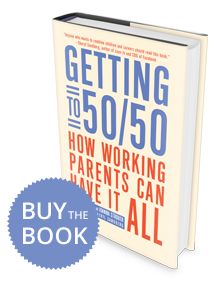Academic Background
Getting to 50/50 draws on research from a across a variety of disciplines. The authors conducted their own survey of 1100 working US mothers. They also interviewed over 200 men and women in dual career couples and employers representing a wide spectrum of jobs and regions of the country (methodology described below). In addition, the authors surveyed the latest research including the NICHD’s landmark work on childcare and child development, sociology studies on the relationship between evenly shared housework/earnings and divorce risk and the correlation of female managers with higher earnings for other women workers, economics work on how having a working spouse impacts earnings and organizational behavior studies on time-management and performance (link to endnotes below).
Methodology (from the Introduction)
Using what researchers call the snowball method (where one contact leads you to many others), we were amazed by the groundswell of volunteers who emerged to share their stories. As one working mom told us, “Happy working couples are culturally invisible. That needs to change.” We told our interviewees we would describe their real jobs but give them fake names. We’ve found that this topic is such a hot one, few people will go on record telling you what they really think—they worry they’ll rub coworkers and friends the wrong way. (And how many bosses will say this in public? “I discriminated,” the ex-chief of a large company told us, explaining how he dealt with working moms.)
We chose to focus most of our interviews on mid- career couples who talked about the rewards of staying the course. Though most are college graduates, these men and women are not “celebrity” working parents who can afford to outsource every domestic challenge. These couples devote themselves to their families and two careers because they believe it’s a good thing—not because it’s easy.
To get broader input, we also conducted an online survey called “The Real Lives of Working Mothers.” Professional organizations, mothers’ clubs, and school groups sent the survey to thousands of women across the country—who forwarded the survey to yet more women. The survey asked questions like these: Does your spouse prefer that you work or not work? Whose career is primary, yours or your spouse’s, or are they equally important? When you returned from your maternity leave, what was your boss’s attitude toward you? What do you tell your children about work and family? Over one thousand working moms wrote in to share their stories from a broad spectrum of careers. Throughout this book, you will find quotes from the survey that we thought would be helpful to our readers and that represented the wide range of respondents’ views and experience.

